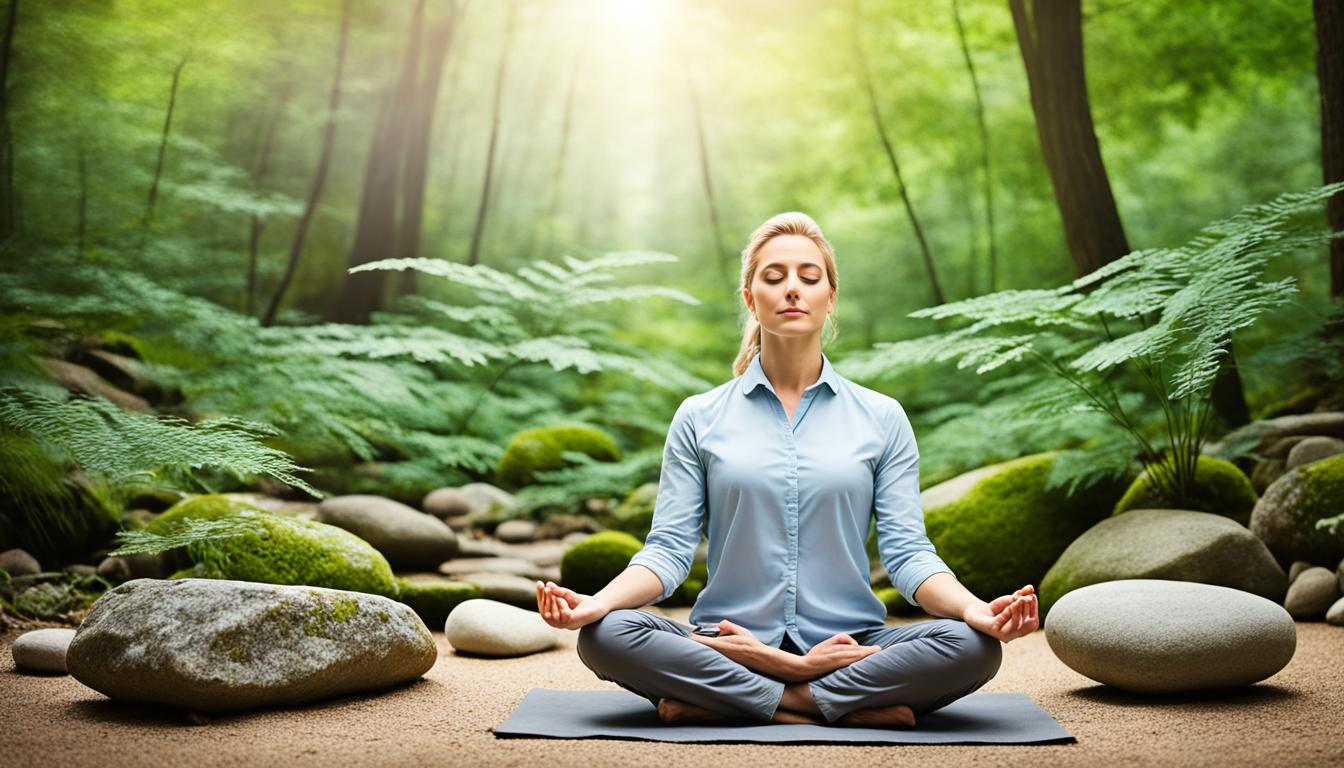Were you aware that the average person spends almost half of their waking hours with a wandering mind? It’s no surprise that many of us feel overwhelmed, disconnected, and searching for inner peace when so much of our day is lost in thoughts, distractions, and chaos from the outside world.
In today’s fast-paced society, finding clarity and inner peace is more important than ever. We need a way to quiet the noise and chaos, reconnect with our true selves, and navigate life with serenity and purpose. The solution lies in the power of stillness.
In this comprehensive inner peace guide, we will explore the transformative benefits of cultivating stillness and how it can bring clarity to our lives. From understanding the importance of stillness to discovering practical techniques and ancient wisdom, we will embark on a journey towards finding true inner peace.
Key Takeaways:
- Stillness is essential in finding clarity and inner peace in our hectic lives.
- Spending nearly half of our waking hours with a wandering mind hinders our ability to be present and connected.
- Incorporating stillness into our daily routines can reduce stress and improve well-being.
- Practices like mindfulness meditation and loving-kindness meditation can help cultivate stillness.
- Nature connection, moving meditations, and rituals are powerful tools for finding inner stillness and balance.
Understanding the Importance of Stillness
In our fast-paced world, stillness is often overlooked. However, it plays a vital role in our overall well-being. Taking the time to cultivate stillness allows us to recharge, reduce stress, and improve our mental and physical health. It is not a selfish act but rather a necessary component of self-care and finding inner peace.
When we embrace stillness, we give ourselves the opportunity to disconnect from the constant noise and distractions that surround us. It is in these moments of quiet and solitude that we can truly find clarity and regain balance in our lives.
Stillness has numerous benefits for our well-being. It allows us to calm our racing minds, giving us the space to reflect, process emotions, and gain a deeper understanding of ourselves. By slowing down and being present in the moment, we create an environment for self-discovery and personal growth.
“In the midst of movement and chaos, keep stillness inside of you.”
Physically, stillness can help reduce the negative effects of stress on our bodies. It promotes relaxation, lowers blood pressure, and boosts our immune system. By incorporating stillness into our daily lives, we give ourselves the opportunity to recharge and rejuvenate, improving our overall health and well-being.
Stillness is not about doing nothing; it is about finding a quiet space within ourselves amidst the busyness of life. It is in this stillness that we can find the clarity and peace we seek.
The Science of Stillness
Research has revealed fascinating insights into the science of stillness and its profound effects on the brain and body. When we embrace a state of stillness, our brainwaves undergo a remarkable transformation. The fast-paced beta waves, associated with active thinking and problem-solving, give way to slower and more tranquil brainwaves.
These slower brainwaves, such as alpha and theta waves, are typically present during deep relaxation, meditation, and moments of clarity. They signify a state of heightened awareness and increased cognitive function.
“In the stillness, we find our true selves.”
A study conducted by neuroscientists at Harvard University found that practicing stillness through meditation can activate the prefrontal cortex, the area of the brain responsible for executive functions like attention, self-regulation, and complex decision-making.
Additionally, when we engage in stillness, the production of stress hormones like cortisol decreases, resulting in a more balanced stress response system and improved overall well-being.
Moreover, research has shown that cultivating stillness has a positive impact on our immune system. The practice of stillness stimulates the production of immune-boosting cells, enhancing our body’s ability to fight off illnesses and reducing the risk of chronic diseases.
Embracing stillness also supports our physical health. It lowers blood pressure, reduces inflammation, and improves cardiovascular health. By inducing a state of relaxation, stillness allows our bodies to rest and rejuvenate, aiding in muscle repair and promoting better sleep.
In summary, the study of the science of stillness reveals how this practice positively influences our brain and body. It slows down brainwaves, enhances cognitive function, reduces stress, improves immune function, and promotes overall health and well-being.
The Effects of Stillness on the Brain and Body
| Effect of Stillness | Impact on the Brain | Impact on the Body |
|---|---|---|
| Slowing of Brainwaves | Increased relaxation and improved cognitive function | Reduced stress and balanced stress response system |
| Enhanced Immune Function | Stimulation of immune-boosting cells, reducing the risk of illness | Improved overall health and reduced risk of chronic diseases |
| Physical Health Benefits | Lower blood pressure, reduced inflammation, improved cardiovascular health | Promotion of muscle repair and better sleep |
By understanding the profound impact of stillness on our brain and body, we can appreciate its significance and prioritize its inclusion in our lives. The next section explores different techniques for cultivating stillness, providing practical tools to experience its transformative benefits.
Techniques for Cultivating Stillness
In our quest for stillness, we can explore various techniques that promote a calm and focused mind. Mindfulness and meditation practices are powerful tools that can help us cultivate stillness and find inner peace. Let’s dive into these techniques and discover how they can bring us closer to a state of deep calm.
Mindfulness Practices
Mindfulness is the practice of bringing our attention to the present moment with nonjudgmental awareness. It involves tuning in to our thoughts, emotions, and bodily sensations without getting caught up in them. By cultivating mindfulness, we can develop a heightened sense of self-awareness and an ability to observe our experiences without reacting to them.
Mindfulness can be practiced in various ways, such as:
- Body scan meditation, where we systematically bring our attention to each part of our body, noticing any sensations or areas of tension.
- Walking meditation, in which we focus on the physical sensations of walking, the movements of our body, and the environment around us.
- Eating meditation, where we bring mindful awareness to each bite of food, savoring the flavors, textures, and the act of nourishing our bodies.
By incorporating mindfulness practices into our daily lives, we can train our minds to be fully present in each moment, fostering a sense of stillness and clarity.
Meditation Practices
Meditation is a practice that involves focusing the mind and relaxing the body. It can be an excellent tool for cultivating stillness and finding inner peace. There are various meditation techniques that we can explore, including:
- Focused attention meditation, where we concentrate on a single point of focus, such as our breath, a phrase, or a visual object.
- Loving-kindness meditation, in which we cultivate feelings of compassion and goodwill towards ourselves and others.
- Transcendental meditation, a technique that involves repeating a mantra silently to oneself to achieve a state of deep relaxation and inner stillness.
During meditation, we create a space for stillness to emerge. As we practice regularly, we train our minds to let go of distractions and experience a sense of calmness and tranquility. By incorporating deep breathing exercises, gentle yoga poses, and other relaxation techniques, we can enhance the experience of stillness during meditation.

“Meditation is not a means to an end. It is both the means and the end.”
By exploring mindfulness and meditation practices, we can embark on a journey of self-discovery and cultivate the stillness that resides within us. These techniques provide us with valuable tools to navigate the challenges of daily life and find peace amidst the chaos.
The Power of Breath and Body Awareness
One of the key components of stillness is breath and body awareness. When we consciously pay attention to our breath and the sensations in our body, we can enter the present moment and quiet the restless mind. This practice allows us to cultivate a state of calmness and clarity.

Deep breathing exercises are effective tools for cultivating stillness. By taking slow, deliberate breaths and focusing on the rhythm of inhalation and exhalation, we can anchor ourselves to the present moment and let go of distractions. Deep breathing not only calms the mind but also relaxes the body, reducing tension and stress.
“Breath is the bridge which connects life to consciousness, which unites your body to your thoughts.”
Body scans are another technique for developing body awareness. By systematically bringing our attention to different parts of the body, we can notice any sensations or areas of tension. This practice helps us cultivate a sense of embodiment and release any physical discomfort or emotional tension we may be holding onto.
Benefits of Breath and Body Awareness
The practice of breath and body awareness offers numerous benefits for our well-being:
- Increased presence: By focusing on our breath and body sensations, we become more attuned to the present moment and less consumed by thoughts of the past or worries about the future.
- Reduced stress: Breath and body awareness help activate the body’s relaxation response, leading to a decrease in stress hormones and an overall sense of calmness.
- Enhanced self-awareness: By observing our breath and body, we develop a deeper understanding of the connection between our physical sensations, emotions, and mental states.
- Improved concentration: The practice of breath and body awareness trains our ability to focus and sustain attention, leading to better concentration and mental clarity.
- Heightened mind-body connection: By cultivating awareness of our breath and body, we develop a stronger connection between our physical and mental well-being, leading to a greater sense of harmony.
By incorporating breath and body awareness practices into our daily lives, we can tap into the power of stillness, finding inner clarity, and peace.
Cultivating Presence through Mindfulness Meditation
Mindfulness meditation is a powerful practice that allows us to cultivate presence and stillness in our lives. By bringing awareness to our thoughts, emotions, and physical sensations, we can learn to observe them without judgment and cultivate a sense of inner calm. Mindfulness meditation invites us to fully engage with the present moment, fostering a deep connection with ourselves and the world around us.
There are various ways to practice mindfulness meditation, each offering unique paths to cultivating presence and stillness:
- Focusing on the breath: One approach to mindfulness meditation is to bring attention to the breath. By observing the inhalation and exhalation, we anchor ourselves to the present moment, allowing thoughts to pass by without becoming entangled in them. The breath becomes an anchor, grounding us in the here and now.
- Bringing awareness to body sensations: Another avenue for mindfulness meditation is to tune into the sensations present in our body. By exploring the feelings, tensions, and movements within our physical being, we build a deeper connection to the present moment. This practice helps us become attuned to the signals our body sends us and develop a greater sense of embodiment.
- Repeating a mantra: Mantra meditation involves silently or softly repeating a word or phrase. By bringing our attention to the mantra, we can center ourselves and quiet the mind. The repetition serves as a focal point, leading us to a state of calm and stillness.
Benefits of Mindfulness Meditation
Mindfulness meditation offers a myriad of benefits for our overall well-being. By regularly practicing mindfulness, we can:
- Cultivate presence: Mindfulness meditation allows us to anchor our attention to the present moment, cultivating a deep sense of presence. It helps us become fully engaged in our experiences, fostering a profound connection with ourselves and those around us.
- Reduce stress: The gentle and nonjudgmental nature of mindfulness meditation helps alleviate stress and anxiety. By developing a peaceful response to our thoughts and emotions, we can navigate stressful situations with greater ease and clarity.
- Enhance self-awareness: Mindfulness meditation helps develop self-awareness, enabling us to notice patterns, triggers, and habitual reactions. This increased self-awareness empowers us to make conscious choices and respond to challenges in a more mindful and intentional way.
- Foster emotional resilience: Through mindfulness meditation, we learn to observe our emotions without being overwhelmed by them. This practice nurtures emotional resilience, allowing us to respond to difficult emotions with compassion and cultivate a greater sense of inner peace.
“Mindfulness meditation is a journey that brings us closer to ourselves and the present moment. It is a practice of profound self-discovery and inner growth.”

| Benefits of Mindfulness Meditation | Techniques for Cultivating Mindfulness |
|---|---|
| Cultivates presence | Focusing on the breath |
| Reduces stress and anxiety | Bringing awareness to body sensations |
| Enhances self-awareness | Repeating a mantra |
| Fosters emotional resilience |
Finding Peace through Loving-Kindness Meditation
Loving-kindness meditation is a powerful practice that can bring profound peace, compassion, and connection with others. It involves directing thoughts of love, kindness, and well-wishes towards ourselves and all beings. By cultivating a genuine sense of love and compassion, we can transcend barriers and foster a deeper understanding of our shared humanity.
This practice is based on the belief that all beings deserve happiness, health, and freedom from suffering. By focusing on loving-kindness, we can transform our own hearts and minds, and positively impact our relationships with others.
In loving-kindness meditation, we start by directing loving-kindness towards ourselves, recognizing that self-compassion is the foundation for showing compassion to others. From there, we extend our well-wishes to loved ones, acquaintances, neutral people, and even to those we may find challenging or have conflicts with.
By generating feelings of love and compassion towards others, we cultivate empathy and connection. This practice helps us recognize that we are all interconnected, and that our well-being is intertwined with the well-being of others.
Through loving-kindness meditation, we tap into the innate goodness and kindness within us. It allows us to let go of resentment, anger, and judgment, and replace them with acceptance, understanding, and forgiveness. This shift in mindset and heart-set not only brings us inner peace but also allows us to approach our interactions with others from a place of love and compassion.
Loving-kindness meditation can be a transformative practice, fostering a deep sense of connection and increasing our capacity for compassion. It is especially beneficial when we find ourselves in times of conflict, stress, or feeling disconnected from others. By opening our hearts and extending loving-kindness, we create a ripple effect of love, compassion, and peace in our relationships and communities.

Benefits of Loving-Kindness Meditation
- Cultivates compassion: Loving-kindness meditation helps us cultivate empathy, compassion, and understanding towards ourselves and others.
- Increases emotional well-being: This practice has been shown to improve positive emotions, reduce negative emotions, and increase overall emotional well-being.
- Reduces stress and anxiety: By promoting feelings of peace and relaxation, loving-kindness meditation can reduce stress and anxiety levels.
- Improves relationships: By fostering love, kindness, and empathy, this practice can enhance our relationships and create a more harmonious and supportive environment around us.
- Enhances self-acceptance: Loving-kindness meditation encourages self-compassion, self-acceptance, and self-love, helping us develop a positive and nurturing relationship with ourselves.
Through the practice of loving-kindness meditation, we can create a profound shift in our own lives and in our relationships with others. It allows us to experience a deeper sense of peace, compassion, and connection in a world that can sometimes feel disconnected and chaotic.
“May all beings be happy, may all beings be healthy, may all beings live with ease.” – Traditional loving-kindness meditation mantra
Moving Meditation for Stillness and Balance
When it comes to finding stillness and balance, traditional seated meditation practices are not the only option. Moving meditations such as yoga and tai chi offer a unique and engaging way to cultivate a sense of inner stillness while maintaining physical activity. These practices combine gentle movements with breath awareness, creating a harmonious flow that promotes relaxation, flexibility, and mental focus.

Yoga, which originated in ancient India, is a moving meditation practice that involves a series of postures, breath control, and meditation techniques. It is known for its ability to enhance strength, flexibility, and overall well-being. By synchronizing movement with breath, yoga encourages mindfulness and presence, allowing practitioners to connect with their bodies and find inner stillness.
Tai chi, on the other hand, is a Chinese martial art that has evolved into a popular moving meditation practice. It consists of slow and flowing movements that emphasize balance, coordination, and mind-body connection. Tai chi is often referred to as “meditation in motion,” as it encourages practitioners to focus on the present moment and cultivate a state of inner calmness.
By engaging in moving meditations like yoga and tai chi, we can experience a unique blend of physical and mental benefits. These practices improve flexibility, strength, and posture while simultaneously calming the mind and reducing stress. Regular participation in moving meditations can also enhance body awareness, promote mindfulness, and improve overall well-being.
Benefits of Moving Meditation:
- Promotes relaxation and reduces stress
- Increases flexibility, strength, and balance
- Enhances body awareness and mindfulness
- Improves mental focus and concentration
- Cultivates a sense of inner stillness and peace
Whether you prefer the graceful movements of yoga or the gentle flow of tai chi, incorporating moving meditations into your routine can help you find balance and harmony in both your body and mind. These practices offer a holistic approach to well-being, allowing you to connect with your breath, cultivate mindfulness, and discover a sense of inner stillness that can positively impact all aspects of your life.
| Yoga | Tai Chi |
|---|---|
| Originated in ancient India | Originated in ancient China |
| Focuses on postures and breath control | Emphasizes slow and flowing movements |
| Improves flexibility, strength, and overall well-being | Enhances balance, coordination, and mind-body connection |
| Encourages mindfulness and presence | Cultivates inner calmness and a state of relaxation |
Embracing Stillness in Daily Life
Stillness doesn’t have to be limited to meditation sessions. We can incorporate stillness into our daily lives by practicing mindfulness in everyday activities. By bringing stillness into our daily routines, we can find greater clarity and peace.
When we think of incorporating stillness into daily life, it’s important to remember that it doesn’t require hours of dedicated time. Instead, it’s about cultivating a mindful presence in the activities we already engage in. By being fully present in each moment, we can find stillness amidst the chaos of daily life.
One way to incorporate stillness is through mindful eating. Instead of rushing through meals or eating on the go, take the time to savor each bite. Engage your senses, notice the flavors, textures, and aromas of your food. By being fully present while eating, we bring stillness to a basic daily activity and cultivate a deeper connection with our nourishment.
Another way to embrace stillness in daily life is through mindful communication. In our fast-paced world, it’s easy to get caught up in distractions and become disconnected from the present moment. By actively listening, giving our full attention to the person we are conversing with, we create a space for stillness and deep connection. This simple act of presence enhances our relationships and promotes understanding.
“When we practice mindfulness in our daily activities, we awaken to the richness of each moment and find stillness amidst the busyness of life.”
Furthermore, incorporating stillness into our workspaces can have a profound impact on our productivity and well-being. Taking short breaks throughout the day to pause, breathe, and bring our focus back to the present moment can help recharge our energy and reduce stress. By incorporating stillness into our work routines, we create a harmonious environment that nurtures our creativity and clarity of thought.

Technology is another area where we can bring stillness into our daily lives. Instead of mindlessly scrolling through social media or constantly checking emails, we can practice mindful technology use. Set boundaries on screen time, take breaks from devices, and use technology intentionally and purposefully. By being mindful of how we engage with technology, we can find peace and stillness in our digital interactions.
Finding Stillness in Everyday Moments
Embracing stillness in daily life is about finding moments throughout the day to pause and reconnect with ourselves. Whether it’s through a few deep breaths, observing the natural world around us, or simply taking a moment to appreciate the beauty of the present moment, these small acts of stillness can have a profound impact on our well-being.
By incorporating stillness into our daily lives, we create a sense of balance and harmony. We become more attuned to our inner wisdom and navigate life with greater clarity and peace. Embrace the opportunity to find stillness in the ordinary moments, and let the transformative power of stillness guide you towards greater contentment and fulfillment.
Nature Connection and Stillness
The natural world offers a profound sense of stillness and connection. When we immerse ourselves in nature, whether it’s walking in the woods or sitting by the ocean, we can experience a deep peace and tranquility. Nature has a way of quieting our minds and reconnecting us with the present moment. It invites us to slow down, breathe in the fresh air, and tune in to the rhythms of the earth. In this section, we explore the power of nature in finding stillness, clarity, and inner peace.

Connecting with the Natural World
There is something inherently calming about being in nature. The sights, sounds, and sensations of the natural world have a way of soothing our restless minds and grounding us in the present. We can find solace in the gentle rustling of leaves, the rhythmic crashing of waves, or the melodious chirping of birds. These moments of stillness in nature allow us to escape from the noise and distractions of everyday life, providing a much-needed respite for our souls.
When we connect with the natural world, we tap into a deep sense of interconnectedness and belonging. We realize that we are not separate from nature, but rather an integral part of it. This understanding brings a profound sense of peace and clarity. We begin to see ourselves as part of a larger tapestry of life, and our worries and stresses seem to fade away in the grandeur of the natural world.
Finding Stillness in the Outdoors
Spending time in nature is a powerful way to cultivate stillness within ourselves. As we engage in outdoor activities such as hiking, camping, or simply taking a leisurely stroll, we allow ourselves to be fully present in the moment. We become attuned to the sights, sounds, and sensations of our surroundings, immersing ourselves in the beauty and serenity of nature.
The stillness we find in nature is not just the absence of noise, but a deep sense of inner quietude. It is a state of mind where our thoughts become still, our worries fall away, and we are fully present in the beauty of the present moment. In this state of stillness, we can experience a profound sense of peace, clarity, and connection with the natural world.
The Healing Power of Nature
Nature has a remarkable ability to heal and restore us. Research has shown that spending time in nature can reduce stress, lower blood pressure, boost mood, and improve overall well-being. The healing power of nature lies in its ability to engage our senses and trigger a relaxation response in our bodies.
When we immerse ourselves in nature, we are surrounded by natural beauty, fresh air, and Vitamin D from sunlight. We engage our senses by observing vibrant flowers, feeling the softness of moss beneath our feet, or inhaling the scent of pine trees. These sensory experiences have a calming effect on our nervous system, helping us to relax, unwind, and find stillness within.
The connection between nature and stillness is undeniable. By spending time in the great outdoors, we can tap into the profound sense of stillness that nature offers and reconnect with our true selves. Nature becomes a sanctuary where we can find solace, clarity, and deep inner peace.
“In every walk with nature, one receives far more than he seeks.” – John Muir
| Benefits of Nature Connection | Rewards of Stillness in Nature |
|---|---|
| – Reduced stress and anxiety | – Deep sense of peace and tranquility |
| – Improved mood and mental well-being | – Heightened clarity and focus |
| – Enhanced physical health and vitality | – Increased connection with the natural world |
Cultivating Stillness through Ritual and Ceremony
Rituals and ceremonies have always offered a profound way to cultivate stillness, find peace, and connect with something greater than ourselves. Whether it’s a daily ritual or a special ceremony, these practices create a sacred space for reflection, intention, and connection. By participating in rituals and ceremonies, we can tap into our inner wisdom and find stillness even in the midst of life’s challenges.
Throughout history, cultures and traditions around the world have utilized rituals and ceremonies as powerful tools for spiritual growth and finding inner peace. These practices allow us to step out of our daily routines and enter a realm of heightened consciousness.

“Sacred ceremonies are a gateway to profound stillness and clarity. They invite us to embrace the present moment and connect with the divine essence within.”
Rituals and ceremonies often involve symbolic actions, such as lighting candles, burning incense, or chanting mantras. These actions serve as anchors for our attention, guiding us into a state of focused awareness. As we engage in these rituals, we create a sense of sacredness and invite stillness to enter our hearts and minds.
Participating in rituals and ceremonies offers us a unique opportunity to step out of the busyness of everyday life and find solace in the present moment. It allows us to let go of worries, distractions, and the constant noise of our minds. In this stillness, we can experience profound peace, clarity, and a deep connection to ourselves and the world around us.
Connecting with Stillness: Building a Personal Ritual
Creating a personal ritual can be a powerful way to cultivate stillness and find peace in your own life. It doesn’t need to be elaborate or time-consuming; the key is to make it meaningful and intentional. Here are some steps to help you build your personal ritual:
- Set an intention: Before starting your ritual, set an intention for what you want to cultivate or experience. It could be clarity, inner peace, gratitude, or anything that resonates with you.
- Create a sacred space: Find a quiet place where you can create a sacred space for your ritual. It could be a corner of your room, a garden, or any space that feels special to you.
- Gather meaningful objects: Choose objects that hold personal significance for you. It could be crystals, candles, feathers, or anything that symbolizes the intention you set.
- Engage your senses: Incorporate elements that engage your senses, such as burning incense, playing calming music, or using essential oils. These sensory experiences can help you bring your attention to the present moment.
- Perform ritual actions: Engage in ritual actions that align with your intention. Light a candle, meditate, write in a gratitude journal, or perform any activity that helps you connect with stillness and find peace.
- Embrace the silence: Finally, embrace the silence and stillness that follows your ritual. Allow yourself to be fully present and open to receiving any insights or clarity that may arise.
“Through ritual and ceremony, we can create a bridge between the ordinary and the sacred, finding profound stillness and clarity in the process.”
Remember, a personal ritual is a practice that evolves over time. It can be adapted to fit your needs and preferences as you continue on your journey of finding stillness and peace. Explore different rituals, discover what resonates with you, and allow the power of sacred ceremony to guide you towards inner transformation.
Integrating Stillness into Daily Life
Stillness is not something that can be achieved overnight. It requires patience, commitment, and practice. By integrating stillness into our daily lives, we can gradually create a sense of balance and harmony. This includes finding moments of stillness amidst our busy schedules and making self-care a priority.
Incorporating stillness into our daily routines allows us to find inner peace and clarity even in the midst of the chaos. It’s about creating small pockets of tranquility that nourish our mind, body, and spirit. Whether it’s dedicating a few minutes each morning to quiet contemplation or taking regular breaks throughout the day to reconnect with ourselves, these moments of stillness can have a profound impact on our well-being.
One powerful way to integrate stillness into our daily lives is through mindfulness practices. Mindfulness involves bringing our awareness to the present moment, without judgment or attachment. It’s about fully experiencing the here and now, appreciating the beauty and simplicity of each moment. By practicing mindfulness in our daily activities, such as eating, walking, or even doing chores, we can cultivate a deeper sense of presence and find stillness amid the busyness.
Creating a daily ritual can also be a powerful way to infuse our lives with stillness. Whether it’s starting the day with a few minutes of journaling or ending it with a soothing bath, rituals provide a sacred space for us to slow down, reflect, and reconnect with ourselves. They can serve as anchors that ground us in the present moment and remind us to prioritize self-care.
In addition to mindfulness and rituals, finding balance and harmony in daily life also involves setting boundaries and saying no to activities or commitments that drain our energy. It means creating space for stillness by decluttering our physical and mental environments, letting go of what no longer serves us, and embracing simplicity.
Integrating stillness into our daily lives is a continuous practice that requires our intention and commitment. It’s a lifelong journey of self-discovery and self-care. Each moment of stillness we cultivate can bring us closer to finding balance, harmony, and inner peace.

Benefits of Integrating Stillness into Daily Life:
- Reduced stress and anxiety
- Increased clarity and focus
- Improved overall well-being
- Enhanced self-awareness and self-compassion
- Greater ability to handle challenges and adversity
- Deeper connection with oneself and others
To summarize, integrating stillness into our daily lives is an essential practice for finding balance and harmony. By incorporating mindfulness, rituals, and self-care into our routines, we can create moments of tranquility that nourish our soul and bring us closer to inner peace.
The Wisdom of Stillness in Spiritual Traditions
Many spiritual traditions have long recognized the profound power of stillness as a path to inner peace. Whether it’s Buddhism, Hinduism, Taoism, Christianity, or other traditions, the practice of stillness is often deeply woven into their teachings and rituals. Exploring the wisdom of these traditions can provide us with invaluable insights and guidance on our own journey towards finding inner peace.
In Buddhism, for example, the practice of meditation plays a central role in cultivating stillness and mindfulness. Through meditation, practitioners learn to quiet the mind, observe their thoughts without attachment, and develop a deep sense of present moment awareness. This allows them to connect with their inner selves and experience a profound sense of stillness and clarity.
Hinduism, on the other hand, emphasizes the importance of stillness through practices such as yoga and meditation. Yoga, which combines physical postures, breath control, and meditation, is not only a form of exercise but also a way to quiet the mind and find inner stillness. Similarly, meditation in Hinduism is a practice that aims to bring about a state of deep relaxation and connection with the divine.
Another tradition that embraces stillness is Taoism, where the concept of wu-wei, or non-action, is central to finding inner peace. Taoists believe that by cultivating stillness and aligning ourselves with the flow of the universe, we can find harmony and balance in our lives. Through practices such as qi gong and tai chi, Taoists seek to cultivate stillness in both body and mind.
In Christianity, the practice of contemplative prayer serves as a means of finding stillness and deepening one’s connection with God. Through silent prayer, believers aim to quiet the mind, open their hearts to divine presence, and experience a profound sense of peace and inner stillness. Contemplative practices like lectio divina (sacred reading) and centering prayer help individuals find stillness in the midst of their busy lives.
“Be still, and know that I am God.” – Psalm 46:10
This quote from the Bible beautifully captures the essence of stillness as a means of finding solace and connecting with a higher power, regardless of religious affiliation. Stillness allows us to transcend the noise of the world and tap into a deeper sense of peace and clarity within ourselves.
Exploring the wisdom of these spiritual traditions can inspire us to incorporate stillness practices into our own lives. Whether it’s through meditation, prayer, yoga, or other forms of stillness, these traditions offer us a wealth of knowledge and experience on our journey towards finding inner peace.
| Spiritual Tradition | Stillness Practices |
|---|---|
| Buddhism | Meditation, mindfulness |
| Hinduism | Yoga, meditation |
| Taoism | Qi gong, tai chi |
| Christianity | Contemplative prayer, centering prayer |
By embracing the wisdom of these spiritual traditions and incorporating stillness practices into our daily lives, we can embark on a transformative journey towards finding inner peace, clarity, and harmony.
Conclusion
Stillness is a powerful tool that can guide us on the path to inner peace and clarity. By embracing stillness in our lives and making it a part of our daily routines, we can experience a range of benefits that contribute to our overall well-being.
One of the key benefits of stillness is its ability to reduce stress. In our fast-paced world, taking the time to be still allows us to disconnect from the external noise and find a sense of calm within ourselves. By reducing stress, stillness improves our mental and physical health, leading to increased clarity of mind and improved cognitive function.
Cultivating stillness requires commitment and practice. It is not something that can be achieved overnight, but the rewards are profound. Through stillness, we can connect with our true selves and gain a deeper understanding of our thoughts, emotions, and desires. By finding clarity within, we can navigate life’s challenges with greater ease and make decisions that align with our authentic selves.
As we embark on the journey of cultivating stillness, let us remember that it is a lifelong process. It may not always be easy, but the transformative power of finding clarity and inner peace is worth the effort. So, let us embrace stillness, incorporate it into our daily lives, and experience the profound benefits it brings – a path to inner peace and a life of greater clarity.
FAQ
Why is stillness important?
Stillness is important because it allows us to recharge, reduce stress, and improve our mental and physical health. It is a necessary component of self-care and finding inner peace.
How does stillness affect the brain and body?
Stillness can slow down our brainwaves, leading to increased relaxation and improved cognitive function. It can also reduce stress, improve immune function, and enhance overall health and well-being.
What techniques can help cultivate stillness?
Mindfulness and meditation practices, combined with deep breathing, yoga, and other relaxation techniques, can help cultivate stillness and enhance the experience of clarity and peace.
How can breath and body awareness contribute to stillness?
Paying attention to our breath and the sensations in our body can help bring us into the present moment, calm the mind, and cultivate stillness and clarity.
What is mindfulness meditation and how can it cultivate stillness?
Mindfulness meditation involves bringing awareness to our thoughts, emotions, and physical sensations without judgment. By observing them without attachment, we can cultivate a sense of inner calm and stillness.
How can loving-kindness meditation help in finding peace?
Loving-kindness meditation involves directing thoughts of love, compassion, and well-wishes towards ourselves and others. This practice cultivates a sense of connection and empathy, leading to greater inner peace and harmony in our relationships.
Can moving meditations like yoga and tai chi help cultivate stillness?
Yes, moving meditations like yoga and tai chi combine gentle movements with breath awareness, promoting relaxation, flexibility, and mental focus. They can help us connect with our bodies, cultivate mindfulness, and find inner stillness.
How can stillness be incorporated into daily life?
Stillness can be incorporated into daily life by practicing mindfulness in everyday activities. Being fully present while eating, communicating, working, and engaging with technology can help us find greater clarity and peace.
How does nature connection contribute to stillness?
Spending time in nature, whether it’s walking in the woods or sitting by the ocean, can help quiet our minds and reconnect with our surroundings. Nature connection is a powerful way to find stillness, clarity, and inner peace.
How can rituals and ceremonies help cultivate stillness?
Rituals and ceremonies create a sacred space for reflection, intention, and connection. They can help us tap into our inner wisdom and find stillness in the midst of life’s challenges.
How can stillness be integrated into daily life?
Integrating stillness into daily life requires patience, commitment, and practice. It involves finding moments of stillness amidst busy schedules and making self-care a priority.
What wisdom do spiritual traditions offer on stillness?
Many spiritual traditions recognize the power of stillness as a path to inner peace. Exploring the wisdom of these traditions can provide valuable insights and guidance on our own journey towards stillness.
Augustus is the visionary leader and Editor-in-Chief of Personality-Test.net. With an unwavering commitment to quality and authenticity, he oversees all content, ensuring it enlightens and empowers our audience. Augustus believes deeply in the transformative power of self-awareness and is dedicated to making Personality-Test.net a beacon for those on a journey to understand themselves better.









